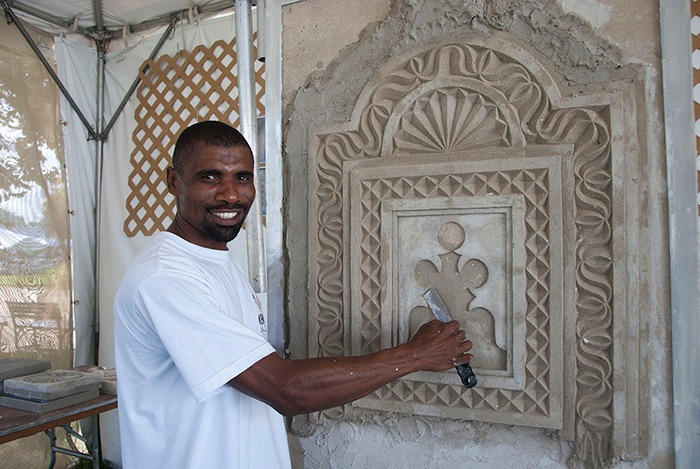Ahmed Yusuf Suleiman: Plaster Art Wizard


Ahmed Yusuf Suleiman at work. Image credit: Smithsonian Folklife Festival
There are a few historical buildings along the Kenyan coast that can be traced back to the 18th century. While the buildings’ have retained form and design and the coral stones or lime mortar used have clearly passed the test of time, conservation has also contributed to the existence of these buildings today. If one travels to Lamu today, some of the historical architecture shows Swahili, Arabic and European influence. But the common factor that binds past and present are the flat-roofed stone homes and the designs of mosques.
Most houses in Lamu have open balconies, interior or exterior walls are decorated with plaster and elegantly curved doors. Ahmed Yusuf Suleiman is a Lamu-based plaster artist whose skill has contributed to the revival of what was at a time considered a dying art.
Back in his primary school days, Ahmed could be found doodling in his free time. His father was a farmer and as was custom, he knew that he would likely take up the same work when he was older. As fate would have it, his family’s livelihood could not afford to keep him in school and his education had to be put on hold. Yet, even in a situation that suggested pessimism, Ahmed had his values tucked deeply within him. He opted to look for work that would sustain him and keep his family fed. He was still a budding artist then, and as he sought informal employment, he hoped that the work he would find would allow him to build his talent.
He’d heard of a carver named Salim whose masonry work had an artistic element which reflected Swahili culture. Ahmed’s interest in seeing Salim’s work up close could not be contained and when he did eventually meet Salim at one of the sites he was working in, Ahmed knew he wanted to do the same work. He apprenticed under Salim and slowly transitioned from pencil art to masonry, plaster art and design. It baffled him to be honest, the beautiful result that came from design, a chisel, mortar and skill. While his apprenticeship days were a season of learning, Ahmed dreamt of a future when he too would be an expert in this art. Though even as he envisioned where he wanted to go, he had come to understand that plaster work wasn’t common in the Lamu. Each day, Ahmed put his best foot forward and in six months, he was able to work independently as a plaster artist. He shared his expertise with young artistically talented locals interested in plaster work, passing on the knowledge just as he’d received from Salim.
His reputation grew around Lamu for the work he did in private homes and soon, through a friend, he was contracted by the National Museums of Kenya to work on a renovation project at the Lamu Museum. Impressed by his work, the museum’s curator informed Ahmed of the Smithsonian Folklife Festival, an international cultural and educational festival that features community-based cultural exemplars. In 2014, Ahmed was one of the crafters representing Kenya in Washington D.C.
The work he presented at the festival was put at the National Museum for African American History and Culture. While most of Ahmed’s work can be found in Lamu, this same craft has taken him to Zanzibar and further south to Mozambique. From the Swahili coast to the world, we celebrate Ahmed Yusuf Suleiman for his mastering of plaster art and his hummingbird work in nurturing the next generation of plaster artists.
#KeCrafters



